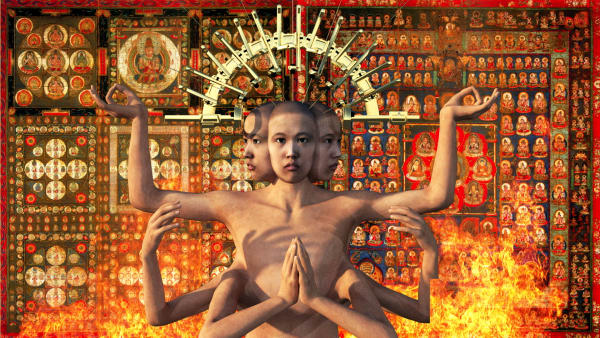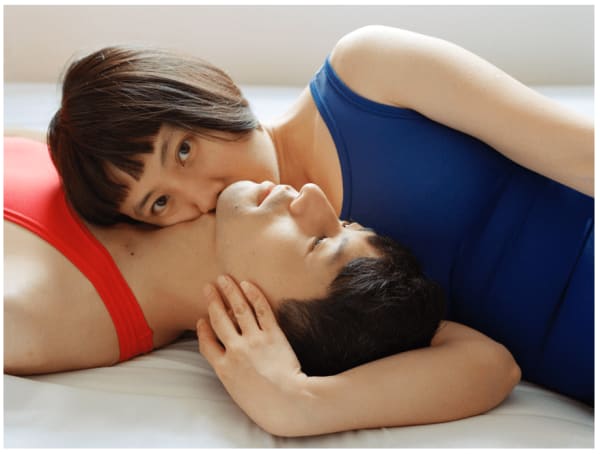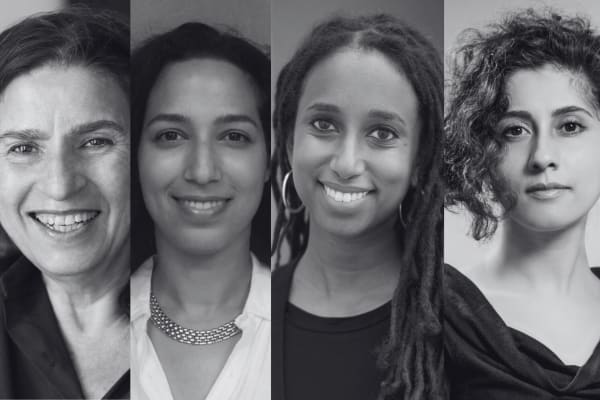Facial Recognition: curated by Barbara Pollack
Facial Recognition gathers a group of artists with unique approaches to portraiture, all working in a moment in history when AI and facial recognition algorithms are inescapable. Taken together, these artists–Pixy Liao, Helina Metaferia, Kambui Olujimi, Azita Moradkhani, Russell Craig, Lau Wai and LuYang–spark a conversation about a shift in depictions of the human face, given the ubiquity of this new technology that insinuates itself into our everyday lives.
AFR–or Automatic Facial Recognition technology–is both invisible and intrusive; from iPhones to TSA, from convenience to surveillance, we take its benefits along with its dangers. Two artists–LuYang and Lau Wai–have mastered facial capture technology only to scrutinize its impact on our understanding of identity and existence. LuYang’s Delusional Mandala is a classic first-look at the way motion capture frees the artist to reinterpret immortality while Lau Wai’s most recent work, reflects their own state of blurred identity promoted by this conversation.
In contrast, several more artists intentionally create hand-made artworks to counteract the seductive qualities of AI and inscribe political messages. For example, AFR is used as a surveillance tool by authoritarian regimes and repressive systems. Azita Moradkhani underscores the way Iranian women are controlled by making visible their identities which are hidden under the ever-present black chador. Russell Craig, who learned to paint in prison, enacts resistance to this constant state of surveillance with his searing portrait of a woman surrounded by guards.
Two other artists who deliberately incorporate emotions, memories, and histories into their portraits, can be seen as counteracting facial recognition systems’ higher margin of error in identifying people of color.¹ Helina Metaferia uses handmade collage to create mesmerizing portraits of political activists, such as Nikole Hannah-Jones, by adding archival images to their elaborate headdresses.
Artist Kambui Olujimi draws parallels in his watercolor paintings, between the digital consumption of the individual and the endurance contests of Depression Era dance marathons. His two porcelain sculptures explore trickster and shapeshifter figures as disruptions to the colonial imagination. Olujimi's sculptures were featured in the 15th edition of the Sharjah Biennial in 2023.
The artist Pixy Liao photographs herself and her spouse, Moro, in ways that merge, disguise, and playfully subvert traditional wedding portraits. By departing from conventional representations, Liao’s work challenges gender roles, deconstructs binaries, and interrogates cultural traditions and societal expectations surrounding portraiture.
Facial Recognition represents a new generation of portraits by artists who create a frisson in the seemingly seamless adoption of AFR in contemporary art circles and elsewhere. While political activists attempt to resist cooperation with facial recognition applications through masks, camouflage and face painting, here we have a group of artists who have ideas of their own about how to subvert the power of this tool.
- Barbara Pollack
¹ Joy Buolamwini and Timnit Gebru, "Gender Shades: Intersectional Accuracy Disparities in Commercial Gender Classification," Proceedings of Machine Learning Research 81 (2018): 1–15, https://proceedings.mlr.press/v81/buolamwini18a/buolamwini18a.pdf
About the Curator
Barbara Pollack is the co-founder of Art at a Time Like This, a nonprofit organization providing a platform for free expression to artists addressing pressing issues of the 21st century. In this capacity, she has curated or organized 15 online exhibitions, 6 public art projects and numerous panels and conferences. Since 1994, Pollack has contributed many articles to the New York Times, Vanity Fair, the Village Voice, Artnews, Hyperallergic, Art in America and Art and Auction, among others. Her most recent book, Brand New Art from China, was published by Bloomsbury in 2018. She has also written essays for many leading and emerging artists including Joyce Kozloff, Jennie Jieun Lee, Liu Ye, LuYang, Zhao Zhao, Zhang Huan and others. This is her second curatorial effort at Jane Lombard Gallery having organized LuYang: Digital Alaya in 2021. More recently, Pollack curated Multiply! Strength in Numbers at the Shanghai Modern Art Museum in 2024 and Mirror Image: A Transformation of Chinese Identity at Asia Society in 2022. Her earlier shows have been presented at Long Museum/Shanghai; Yuz Museum/Shanghai; Asia Society/Texas; Tampa Museum of Art/Florida; Oklahoma City Museum of Art; and Orange County Museum of Art. Her first exhibition, My Friends in My Apartment, literally took place in her loft and was reviewed by New York Magazine and the New York Times Magazine. In support of this research, Pollack received the Andy Warhol Arts Writers Grant in 2008 and two fellowships from Asian Cultural Council in 2008 and 2016.
-
 LuYang, Delusional Mandala, 2015
LuYang, Delusional Mandala, 2015 -
 Azita Moradkhani, Protest (اعتراض), 2025
Azita Moradkhani, Protest (اعتراض), 2025 -
 Azita Moradkhani, In Bloom (شکوفه دادن), 2024
Azita Moradkhani, In Bloom (شکوفه دادن), 2024 -
 Azita Moradkhani, Blind Spot (نقطه کور), 2023
Azita Moradkhani, Blind Spot (نقطه کور), 2023 -
 Helina Metaferia, Headdress 65, 2024
Helina Metaferia, Headdress 65, 2024 -
 Helina Metaferia, Headdress 74, 2025
Helina Metaferia, Headdress 74, 2025 -
 Lau Wai, Decrypted Sentient 02, 2025
Lau Wai, Decrypted Sentient 02, 2025 -
 Kambui Olujimi, Time Gone, 2023
Kambui Olujimi, Time Gone, 2023 -
 Kambui Olujimi, Three Questions of a Tsunami, 2022
Kambui Olujimi, Three Questions of a Tsunami, 2022 -
 Kambui Olujimi, Three Secrets of a Tsunami, 2022
Kambui Olujimi, Three Secrets of a Tsunami, 2022 -
 Russell Craig, 5 Correctional Officers, 2023
Russell Craig, 5 Correctional Officers, 2023 -
 Pixy Liao, Bed wrestling , 2019
Pixy Liao, Bed wrestling , 2019 -
 Pixy Liao, Creating a world just for us, 2013
Pixy Liao, Creating a world just for us, 2013 -
 Pixy Liao, Two Heads, 2019
Pixy Liao, Two Heads, 2019

























